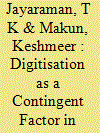|
|
|
Sort Order |
|
|
|
Items / Page
|
|
|
|
|
|
|
| Srl | Item |
| 1 |
ID:
167572


|
|
|
|
|
| Summary/Abstract |
Financial sector development (FSD) has been recognised as a supportive factor, acting as a shift variable in the growth function, besides the fundamental variables of capital stock and labour. Since the beginning of the new millennium, rapid strides in the spread of information and communication technology (ICT) have enabled the hitherto reluctant, urban-based banking institutions to reach the rural masses for mobilising savings. Digitisation through various innovations has made it possible that ‘brick and mortar less’ bank branches now increasingly provide financial services to rural India. This study examines the role of digitisation as a contingent factor in India’s FSD and growth nexus during the last 13 years (2003–2015). The findings of the empirical study through employment of ARDL methodology and application of bounds testing procedure by utilising 52 quarterly observations of the data series of relevant variables reveal that digitisation has indeed emerged a significant factor in the FSD and growth nexus, by playing a complementary role to FSD. There are two policy implications: (a) as ICT has emerged a major tool, it has to be supported at all levels, and (b) the financial inclusion process should be carried forward as it has all the potential to speed up economic growth and development.
|
|
|
|
|
|
|
|
|
|
|
|
|
|
|
|
| 2 |
ID:
167570


|
|
|
|
|
| Summary/Abstract |
This article seeks to deepen our understanding of the globalisation–growth nexus as it extends the investigation to using a spatial econometric approach, hitherto rarely used in the globalisation literature. The objective of the article is to uncover not only the significant growth effects of globalisation but also its possible spillover effects onto neighbouring countries. Using a panel data set of 83 countries across a 30-year period and via a spatial autoregressive panel data method, this article estimates a standard growth model augmented with a parameter to capture the countries’ spatial dependence, whilst controlling for globalisation indices. The findings indicate a positive effect of economic globalisation, which is dependent upon the political settings in the countries under study. The spillover effects of globalisation across neighbouring countries are shown, both in geographical and institutional spheres. The article concludes with some policy recommendations.
|
|
|
|
|
|
|
|
|
|
|
|
|
|
|
|
| 3 |
ID:
167573


|
|
|
|
|
| Summary/Abstract |
This article uses simultaneous equations error component three-stage least squares (EC3SLS) panel data technique to find the direct and indirect impacts of trade, industrial dissimilarity and FDI on the business cycle synchronisation of Eurozone economies. The period of analysis is 1990–2009. These are the major findings: (a) trade, industrial dissimilarity and FDI have both direct and indirect effects on the business cycle synchronisation of sample economies; (b) EC3SLS estimates show that closer trade ties among these Eurozone countries have led to more synchronised business cycle co-movements, because common disturbances are more prevalent and intra-industry trade dominates; (c) the bilateral FDI flows have served as a source of destabilisation rather than a source of synchronisation; (d) industry-specific shocks have almost lost their importance both in terms of generating more trade and in terms of raising the output correlation of sample countries; (e) trade intensity and FDI flows are positively and significantly correlated, thereby suggesting that more FDI encourages more trade and vice-versa; (f) trade shows a negative relationship with industrial dissimilarity, which implies that bilateral trade in these countries promotes similar industrial structures; and finally, (g) these economies characterise intra-industry trade patterns, as expected in the case of these highly integrated Eurozone economies. Although the results show the presence of intra-industry trade types, these economies have diversified their production processes at the higher income levels.
|
|
|
|
|
|
|
|
|
|
|
|
|
|
|
|
| 4 |
ID:
167571


|
|
|
|
|
| Summary/Abstract |
Indian manufacturing industries have experienced the major effects of economic reforms. Since the effect of any policy is ultimately transferred to workers, this article is an attempt to determine the extent to which labour productivity and wages are inter-related in manufacturing industries. The study uses state-level panel data of manufacturing industries and empirically tests the relevance of marginal productivity theory of wages and efficiency wage theory. After confirming the stationarity of the series, various empirical tests such as cointegration, vector error correction mechanism and Granger causality are applied to check the long-run equilibrium relationship between wage growth and productivity growth.
|
|
|
|
|
|
|
|
|
|
|
|
|
|
|
|
|
|
|
|
|